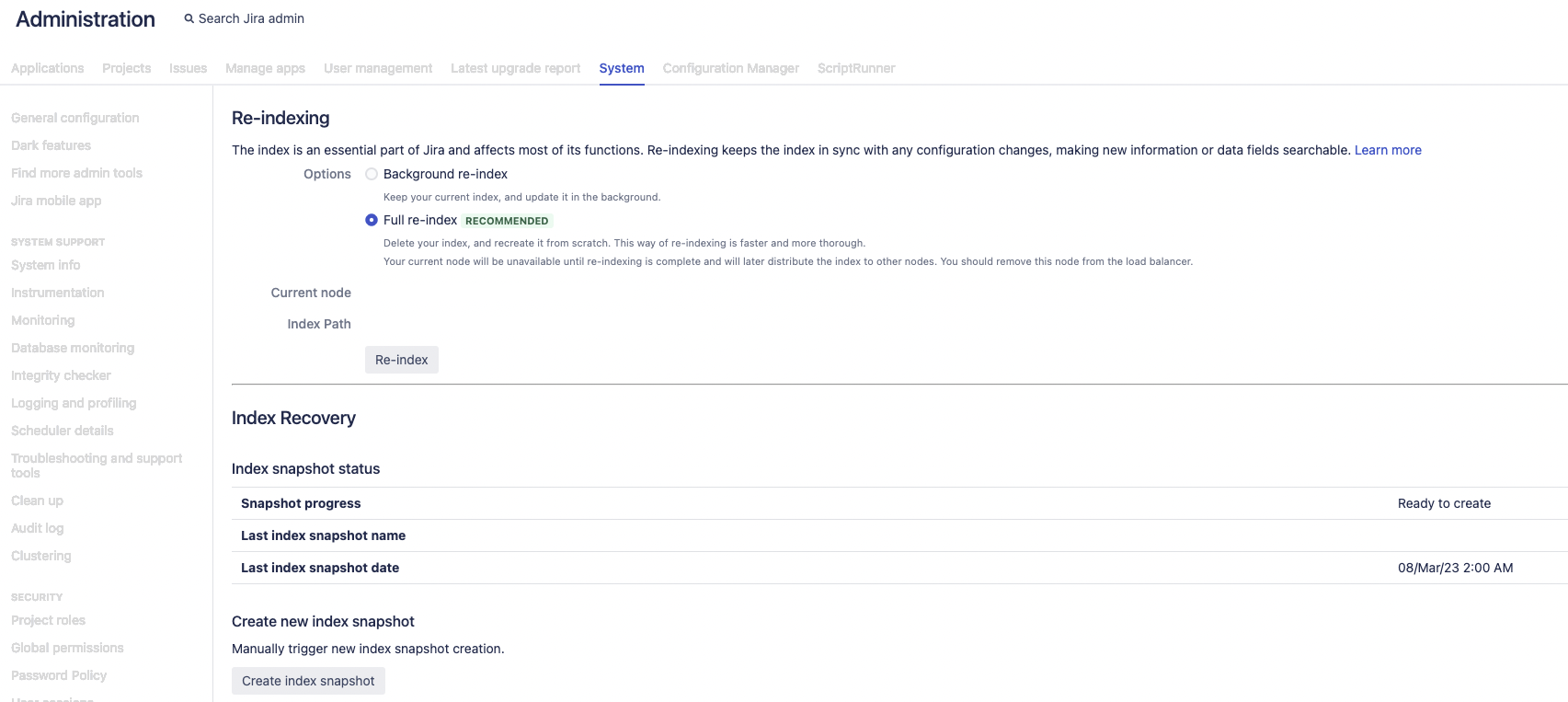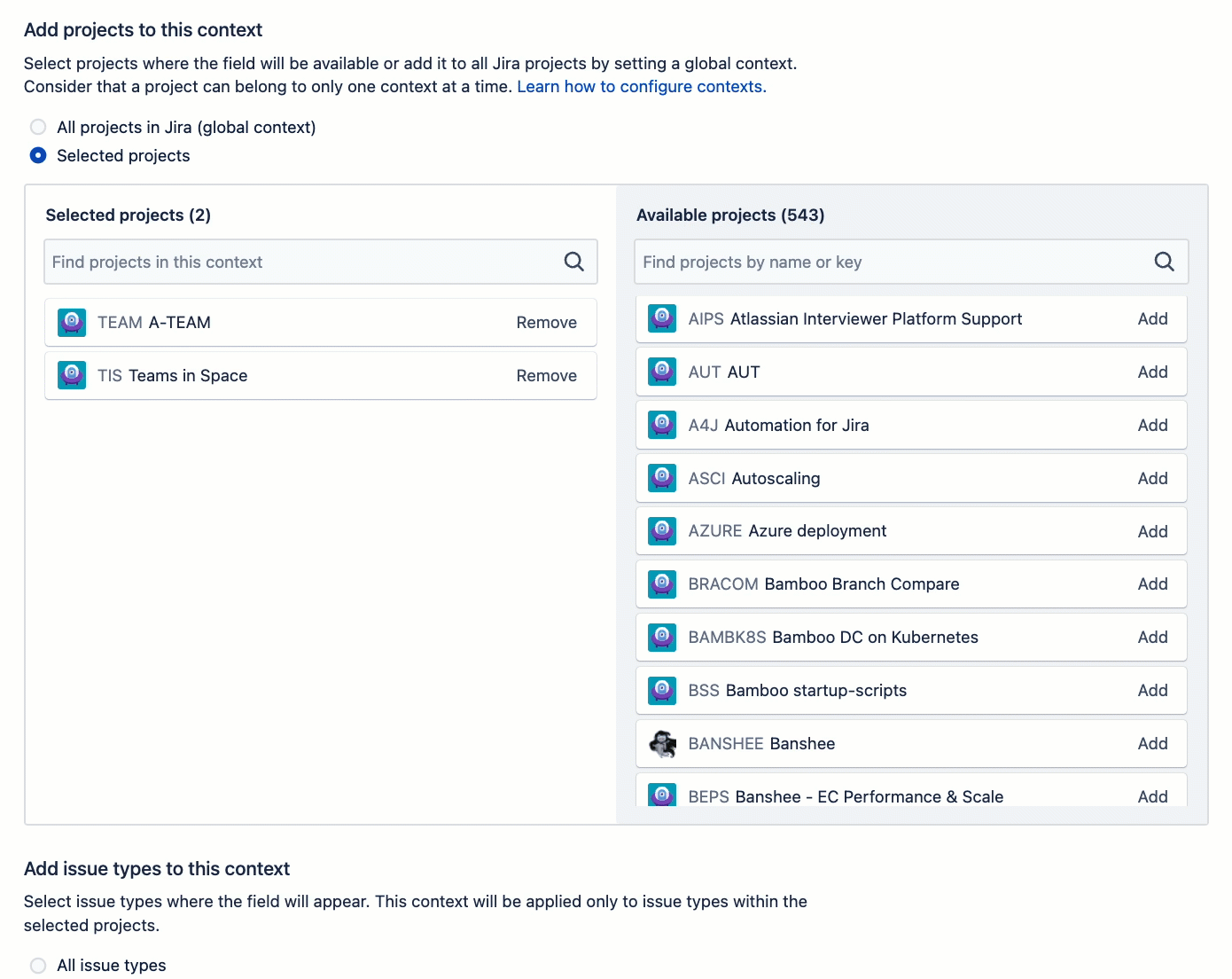Jira Software 9.7.x release notes
20 March 2023
We're pleased to present Jira Software 9.7.Highlights
- Get notified about active sprints when deleting a board with them
- Fixed validation for required custom fields of the Select list (cascading) type
- Pin comments in Jira issues
- Configuring contexts for custom fields: new design, enhanced functionality
- Version’s start and release dates are now consistently displayed in the app
- Take index snapshots with one click
- End of support announcements
- Known issues
- Resolved issues
Upgrading from 8.x to 9.x triggers full Jira reindex that causes some downtime during the process. If you’re on 8.x now, make sure you’ve estimated the downtime and set the best time for the upgrade.
Learn more about how to handle full reindex and estimate downtime
Read the upgrade notes for important info about this release and see the full list of issues resolved.
Compatible applications
If you're looking for compatible Jira applications, look no further:
Good to know
If you're thinking of moving to Data Center, check our recommendations first. See: Infrastructure recommendations for Jira.
Get notified about active sprints when deleting a board with them
In previous versions, when you were deleting a scrum board, you couldn’t know if it contained any active sprints or not. This information wasn’t clear from the notification you got before the deletion. As a result, you could lose the data on currently running sprints and had no explicit workaround to restore it.
In Jira 9.7, we’ve updated the notification that appears when you want to delete a scrum board.
In the notification, we’ll show you the list of active sprints the board contains and recommend that you complete them before deleting the board. At the same time, we don’t block the deletion of the board.
When you close the active sprints the board contains, you can safely proceed with deleting it. So you won’t lose the teamwork done during the sprints and won’t have to restore the data.
Fixed validation for required custom fields of the Select list (cascading) type
We’ve fixed the validation for custom fields of the Select list (cascading) type when they’re set as required. Now, when you're creating or editing issues, Jira checks if a mandatory custom field of this type in them contains enabled and correctly related parent and child options. If not, you won’t be able to save an issue or changes to it.
The validation ensures that the hierarchy of the field’s options is preserved and displayed correctly in the issue view. A custom field of the Select list (cascading) type passes the validation when:
The field has a parent option without child options, the parent is enabled and set as the field’s value.
The field has a parent option with child options, the parent and at least one child are enabled, and both the parent and the enabled child are set as the field’s values.
Required custom fields of the other types are validated according to the regular scenario: a required field passes the validation if it contains at least one value.
Learn more about the validation for required custom fields
Take index snapshots with one click
Jira admins can now create index snapshots on a given node with a single click at any time. This is helpful when, for example, you want to create an index backup before the Jira reindex. No more need for a cumbersome workaround with a manually scheduled service.
This improvement doesn’t replace default scheduled index snapshots.
To take an index snapshot manually:
- Go to Administration > System.
- In the left-side panel, select Indexing.
- On the Indexing page, go to Create new index snapshot and select Create index snapshot.
Check your mail queue's health
We’re adding a new health check that will help Jira admins determine if emails are sent from mail queues without any issues. If there ever are emails in your queue that haven’t been sent within a specified amount of time, this check won’t pass. The warning you’ll see could mean that your instance is having trouble sending emails regularly or isn’t sending them at all, which could result in delayed communication between Jira and your users.
If you’re a Jira admin and want to verify the status of your mail queue, go to Administration > System > Troubleshooting and support tools > Instance health.
In Jira 9.7, you’ll only be able to see the results on the Troubleshooting and support tools page if the check passes without any issues. If something is wrong with your mail queue, you won’t see the name or results of the check on the Troubleshooting and support tools page. The results of the check will only be visible in your Jira logs.
This feature will be fully functional in the next Jira release.
For more information on how this check works, check out our Knowledge Base article on the mail queue health check.
Pin comments in Jira issues
Have you ever read hundreds of comments only to get to the one that really matters to you? Maybe you even had to do that again, just after refreshing the page or visiting it after some time. This release comes with the solution to such challenges as we’re introducing the ability to pin comments in Jira.
All important comments you’ve pinned will always appear at the top of the Comments tab, above the other issue comments:
- Pinned comments: a section that contains all comments that are currently pinned on an issue.
- All comments: a section with all issue comments, including the pinned ones.
So, what has changed so far?
- Regardless of the sorting applied, pinned comments always appear in the same order, with the most recent ones displayed at the top.
- You can pin up to five comments on a single issue, being sure that only essential information is pinned and other users won’t miss a thing.
- Both pinned comments and all other comments are wrapped up in separate sections - Pinned comments and All comments so you know exactly where to look for the needed information.
- Pinned comments appear in both sections. You can edit, unpin, or delete (only added by you) them in either place.
Learn more about pinned comments
Configuring contexts for custom fields: new design, enhanced functionality
Your feedback has always been fuel for any Jira improvements, helping us to work on things that really matter and bring value to your everyday work. This time, we’re glad to announce improvements long-awaited by Jira admins - we’ve revamped the whole experience of configuring custom field contexts.
Meet a brand-new design and enhanced functionality, as we’ve been working hard to ensure you’re getting a quick, efficient, and predictable interaction with the feature, achieving more in less time. Let’s get it uncovered!
- Use search to quickly find what you’re looking for. No more scrolling through long lists of issue types and projects, even if it’s just one item you need to select.
- Easily add or remove items from the context by dragging and dropping those between lists. Or simply use Add or Remove buttons, and have it done.
- Avoid repetitive manual steps with the multi-select functionality. Select while holding the Shift key to choose multiple items at one go.
- No more worries about misclicks. Once you add items to the needed list, clicking outside that list won’t clear the selection.
- Validate your changes in a glimpse as all newly added items now appear in a separate Just added section. No matter how many items you’ve added to the context, all new selections will stand out.
- Is it “context” or “Custom field configuration scheme”? No more guesses as we make the terminology consistent throughout the app and documentation. We want to keep things simple and clear, so Context it is.
Take a look at this demo to get quickly familiar with the updates, and try it yourself.
Learn more about configuring contexts for custom fields
Version’s start and release dates are now consistently displayed in the app
Have you ever been surprised by checking the project’s version dates and noticing that release is happening sooner than originally scheduled? Similar inconsistencies between the start and end dates for a version have been a source of confusion for many users, and we’re excited to announce that it’s fixed in this release!
We’ve improved the way version dates are displayed to users with different time zone settings. Instead of using Jira system time to show both Start and Release dates for a version, we use current users’ time zones. Additionally, we present information on the currently configured date and time in tooltips so it can be easily checked in one click.
From now on, no matter where you or your team members are located, you can be sure that the release is happening exactly at the time you see in the app on the Releases page.
End of support announcements
SQL Server 2016
In Jira 9.7, we’re permanently removing support for SQL Server 2016. End of support means that we won’t fix bugs related to this platform in Jira 9.7 and later.
At the same time, we continue supporting SQL Server 2017 and SQL Server 2019.
Java 8
We’re planning to stop supporting Java 8 in upcoming releases. You can use it with Jira 9.7 until we announce the deprecation of Java 8.
Follow the updates in supported platforms and the announcements about the end of platform support.
Known issues
This is a known issues in JMX monitoring.
We're using a blocklist deserialization filter based on ObjectInputFilter from JVM. If you miss appropriate classes in your classpath based on the Java version, your Jira node won’t be started.
We’re working to release a fix for this issue in the upcoming versions. For now, we recommend checking the following classes in your JDK:
- For JDK 8: ensure the class
sun.misc.ObjectInputFilteris in your classpath. - For JDK 11 and later: ensure the class
java.io.ObjectInputFilteris in your classpath.
For updates, reference Jira Software release notes.
Resolved issues
Issues resolved in 9.7.0
Released on 20 March 2023
Issues resolved in 9.7.1
Released on 13 April 2023
Issues resolved in 9.7.2
The Atlassian Jira team is pleased to announce the release of Jira Software 9.7.2.
Don't have Jira Software 9.7.x yet?
Check out the new features and other highlights in the Jira Software 9.7.x release notes.





